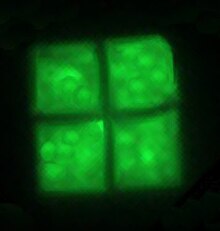| Haloquadratum walsbyi | |
|---|---|

| |
| Haloquadratum walsbyi (drawing, 2008) | |

| |
| Haloquadratum walsbyi (SEM image, 2023) | |
| Scientific classification | |
| Domain: | |
| Phylum: | |
| Class: | |
| Order: | |
| Family: | |
| Genus: | |
| Species: | H. walsbyi
|
| Binomial name | |
| Haloquadratum walsbyi Burns et al. 2007
| |
Haloquadratum walsbyi is a species of Archaea in the genus Haloquadratum, known for its square shape and halophilic nature.[1]
First discovered in a brine pool in the Sinai peninsula of Egypt, H. walsbyi is noted for its flat, square-shaped cells, and its unusual ability to survive in aqueous environments with high concentrations of sodium chloride and magnesium chloride.[2][1] The species' genus name Haloquadratum translates from Greek and Latin as "salt square". This archaean is also commonly referred to as "Walsby's Square Bacterium" because of its identifying square shape which makes it unique.[3] In accordance with its name, Haloquadratum walsbyi are most abundantly observed in salty environments.
Haloquadratum walsbyi is a phototrophic halophilic archaeon. It was the only recognized species of the genus Haloquadratum until 1999 when Haloarcula quadrata was reported as recovered from a brine pool.[2] Haloquadratum walsbyi is very unusual because of its unique cellular structure that resembles an almost-perfectly flat-shaped figure.
The genus was first observed in 1980 by a British microbiologist, Prof. Anthony E. Walsby, from samples taken from the Sabkha Gavish, a brine lake in southern Sinai, Egypt. This discovery is formally described in 2007 by Burns et al. Attempts to cultivate the archaea were unsuccessful until 2004 and resulted in the identification of Haloarcula quadrata, another species of square archaea of the genus Haloarcula, distinct from H. walsbyi, less abundant and genetically quite different.
- ^ a b Bolhuis H, Palm P, Wende A, Falb M, Rampp M, Rodriguez-Valera F, et al. (July 2006). "The genome of the square archaeon Haloquadratum walsbyi : life at the limits of water activity". BMC Genomics. 7: 169. doi:10.1186/1471-2164-7-169. PMC 1544339. PMID 16820047.
- ^ a b Oren A, Ventosa A, Gutiérrez MC, Kamekura M (July 1999). "Haloarcula quadrata sp. nov., a square, motile archaeon isolated from a brine pool in Sinai (Egypt)". International Journal of Systematic Bacteriology. 49 (3): 1149–1155. doi:10.1099/00207713-49-3-1149. PMID 10425773.
Square bacteria were first observed in 1980 by Walsby in the Gavish Sabkha, a coastal brine pool in the Sinai peninsula, Egypt (Parkes & Walsby, 1981; Walsby, 1980). Walsby recognized these extremely thin, square-shaped structures as prokaryotes...
- ^ Oesterhelt D (2022). "Haloquadratum walsbyi - overview". Max Planck Institute of Biochemistry. Max-Planck-Gesellschaft. Retrieved 2022-11-16.